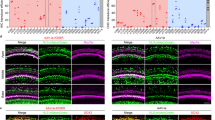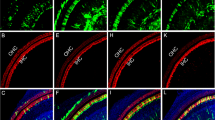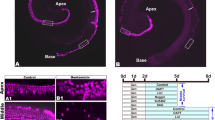Abstract
Once inner ear hair cells (HCs) are damaged by drugs, noise or aging, their apical structures including the stereociliary arrays are frequently the first cellular feature to be lost. Although this can be followed by progressive loss of HC somata, a significant number of HC bodies often remain even after stereociliary loss. However, in the absence of stereocilia they are nonfunctional. HCs can sometimes be regenerated by Atoh1 transduction or Notch inhibition, but they also may lack stereociliary bundles. It is therefore important to develop methods for the regeneration of stereocilia, in order to achieve HC functional recovery. Espin is an actin-bundling protein known to participate in sterociliary elongation during development. We evaluated stereociliary array regeneration in damaged vestibular sensory epithelia in tissue culture, using viral vector transduction of two espin isoforms. Utricular HCs were damaged with aminoglycosides. The utricles were then treated with a γ-secretase inhibitor, followed by espin or control transduction and histochemistry. Although γ-secretase inhibition increased the number of HCs, few had stereociliary arrays. In contrast, 46 h after espin1 transduction, a significant increase in hair-bundle-like structures was observed. These were confirmed to be immature stereociliary arrays by scanning electron microscopy. Increased uptake of FM1-43 uptake provided evidence of stereociliary function. Espin4 transduction had no effect. The results demonstrate that espin1 gene therapy can restore stereocilia on damaged or regenerated HCs.
This is a preview of subscription content, access via your institution
Access options
Subscribe to this journal
Receive 12 print issues and online access
$259.00 per year
only $21.58 per issue
Buy this article
- Purchase on Springer Link
- Instant access to full article PDF
Prices may be subject to local taxes which are calculated during checkout








Similar content being viewed by others
References
Nadol JB Jr . Hearing loss. N Engl J Med 1993; 329: 1092–1102.
Roberson DF, Weisleder P, Bohrer PS, Rubel EW . Ongoing production of sensory cells in the vestibular epithelium of the chick. Hear Res 1992; 57: 166–174.
Ryals BM, Rubel EW . Hair cell regeneration after acoustic trauma in adult Coturnix quail. Science 1988; 240: 1774–1776.
Gale JE, Meyers JR, Periasamy A, Corwin JT . Survival of bundleless hair cells and subsequent bundle replacement in the bullfrog's saccule. J Neurobiol 2002; 50: 81–92.
Jia S, Yang S, Guo W, He DZ . Fate of mammalian cochlear hair cells and stereocilia after loss of the stereocilia. J Neurosci 2009; 29: 15277–15285.
Sekerková G, Zheng L, Loomis PA, Mugnaini E, Bartles JR . Espins and the actin cytoskeleton of hair cell stereocilia and sensory cell microvilli. Cell Mol Life Sci 2006; 63: 2329–2341.
Sekerkov G, Zheng L, Mugnaini E, Bartles JR . Differential expression of espin isoforms during epithelial morphogenesis, stereociliogenesis and postnatal maturation in the developing inner ear. Dev Biol 2006; 291: 83–95.
Li H, Liu H, Balt S, Mann S, Corrales CE, Heller S . Correlation of expression of the actin filament-bundling protein espin with stereociliary bundle formation in the developing inner ear. J Comp Neurol 2004; 468: 125–134.
Rzadzinska A, Schneider M, Noben-Trauth K, Bartles JR, Kachar B . Balanced levels of Espin are critical for stereociliary growth and length maintenance. Cell Motil Cytoskeleton 2005; 62: 157–165.
Zheng L, Sekerková G, Vranich K, Tilney LG, Mugnaini E, Bartles JR . The deaf jerker mouse has a mutation in the gene encoding the espin actin-bundling proteins of hair cell stereocilia and lacks espins. Cell 2000; 102: 377–385.
Van de, Water TR, Staecker H, Halterman MW, Federoff HJ . Gene therapy in the inner ear. Mechanisms and clinical implications. Ann NY Acad Sci 1999; 884: 345–360.
Ryan AF, Dazert S . Gene therapy for the inner ear: challenges and promises. Adv Otorhinolaryngol 2009; 66: 1–12.
Kawamoto K, Yagi M, Stover T, Kanzaki S, Raphael Y . Hearing and hair cells are protected by adenoviral gene therapy with TGF-beta1 and GDNF. Mol Ther 2003; 7: 484–492.
Kawamoto K, Sha SH, Minoda R, Izumikawa M, Kuriyama H, Schacht J et al. Antioxidant gene therapy can protect hearing and hair cells from ototoxicity. Mol Ther 2004; 9: 173–181.
Izumikawa M, Minoda R, Kawamoto K, Abrashkin KA, Swiderski DL, Dolan DF et al. Auditory hair cell replacement and hearing improvement by Atoh1 gene therapy in deaf mammals. Nat Med 2005; 11: 271–276.
Schlecker C, Praetorius M, Brough DE, Presler RG Jr, Hsu C, Plinkert PK et al. Selective atonal gene delivery improves balance function in a mouse model of vestibular disease. Gene Ther 2011; 18: 884–890.
Tona Y, Hamaguchi K, Ishikawa M, Miyoshi T, Yamamoto N, Yamahara K et al. Therapeutic potential of a gamma-secretase inhibitor for hearing restoration in a guinea pig model with noise-induced hearing loss. BMC Neurosci 2014; 15: 66.
Mizutari K, Fujioka M, Hosoya M, Bramhall N, Okano HJ, Okano H et al. Notch inhibition induces cochlear hair cell regeneration and recovery of hearing after acoustic trauma. Neuron 2013; 77: 58–69.
Lin V, Golub JS, Nguyen TB, Hume CR, Oesterle EC, Stone JS . Inhibition of Notch activity promotes nonmitotic regeneration of hair cells in the adult mouse utricles. J Neurosci 2011; 31: 15329–15339.
Ahmed M, Xu J, Xu PX . EYA1 and SIX1 drive the neuronal developmental program in cooperation with the SWI/SNF chromatin-remodeling complex and SOX2 in the mammalian inner ear. Development 2012; 139: 1965–1977.
Atkinson PJ, Huarcaya Najarro E, Sayyid ZN, Cheng AG . Sensory hair cell development and regeneration: similarities and differences. Development 2015; 142: 1561–1571.
Ryan AF . The cell cycle and the development and regeneration of hair cells. Curr Top Dev Biol 2002; 57: 449–466.
Loomis PA, Zheng L, Sekerková G, Changyaleket B, Mugnaini E, Bartles JR . Espin cross-links cause the elongation of microvillus-type parallel actin bundles in vivo. J Cell Biol 2003; 163: 1045–1055.
Gale JE, Marcotti W, Kennedy HJ, Kros CJ, Richardson GP . FM1-43 dye behaves as a permeant blocker of the hair-cell mechanotransducer channel. J Neurosci 2001; 21: 7013–7025.
Meyers JR, MacDonald RB, Duggan A, Lenzi D, Standaert DG, Corwin JT et al. Lighting up the senses: FM1-43 loading of sensory cells through nonselective ion channels. J Neurosci 2003; 23: 4054–4065.
Griesinger CB, Richards CD, Ashmore JF . FM1-43 reveals membrane recycling in adult inner hair cells of the mammalian cochlea. J Neurosci 2002; 22: 3939–3952.
Yang SM, Chen W, Guo WW, Jia S, Sun JH, Liu HZ et al. Regeneration of stereocilia of hair cells by forced Atoh1 expression in the adult mammalian cochlea. PLoS One 2012; 7: e46355.
Masuda M, Dulon D, Pak K, Mullen LM, Li Y, Erkman L et al. Regulation of POU4F3 gene expression in hair cells by 5' DNA in mice. Neuroscience 2011; 197: 48–64.
Erkman L, McEvilly RJ, Luo L, Ryan AK, Hooshmand F, O'Connell SM et al. Role of transcription factors Brn-3.1 and Brn-3.2 in auditory and visual system development. Nature 1996; 381: 603–606.
Xiang M, Zhou L, Macke JP, Yoshioka T, Hendry SH, Eddy RL et al. The Brn-3 family of POU-domain factors: primary structure, binding specificity, and expression in subsets of retinal ganglion cells and somatosensory neurons. J Neurosci 1995; 15: 4762–4785.
Yamamoto N, Tanigaki K, Tsuji M, Yabe D, Ito J, Honjo T . Inhibition of Notch/RBP-J signaling induces hair cell formation in neonate mouse cochleas. J Mol Med (Berl) 2006; 84: 37–45.
Hori R, Nakagawa T, Sakamoto T, Matsuoka Y, Takebayashi S, Ito J . Pharmacological inhibition of Notch signaling in the mature guinea pig cochlea. Neuroreport 2007; 18: 1911–1914.
Murata J, Ikeda K, Okano H . Notch signaling and the developing inner ear. Adv Exp Med Biol 2012; 727: 161–173.
He TC, Zhou S, da Costa LT, Yu J, Kinzler KW, Vogelstein B . A simplified system for generating recombinant adenoviruses. Proc Natl Acad Sci USA 1998; 95: 2509–2514.
Taura A, Kojima K, Ito J, Ohmori H . Recovery of hair cell function after damage induced by gentamicin in organ culture of rat vestibular maculae. Brain Res 2006; 1098: 33–48.
Acknowledgements
We thank Professor James Bartles (Northwestern University) for kindly providing plasmids encoding espin1 and espin4 conjugated to EGFP. This research was supported by a Health and Labor Science Research Grant for Research on Specific Disease (Vestibular Disorders) from the Ministry of Health, Labor and Welfare, Japan (2014), a Grant-in-Aid for Scientific Research from the Ministry of Education, Science, Sports, Culture and Technology of Japan, and grant BX001205 from the Veterans Administration of the United States. The ARRIVE guidelines were followed in experimental design and completion, as well as manuscript preparation.
Author information
Authors and Affiliations
Corresponding author
Ethics declarations
Competing interests
The authors declare no conflict of interest.
Rights and permissions
About this article
Cite this article
Taura, A., Taura, K., Koyama, Y. et al. Hair cell stereociliary bundle regeneration by espin gene transduction after aminoglycoside damage and hair cell induction by Notch inhibition. Gene Ther 23, 415–423 (2016). https://doi.org/10.1038/gt.2016.12
Received:
Revised:
Accepted:
Published:
Issue Date:
DOI: https://doi.org/10.1038/gt.2016.12



